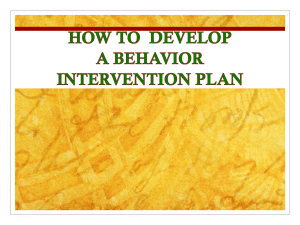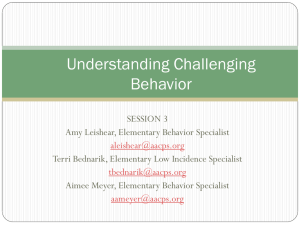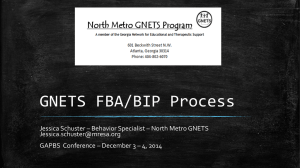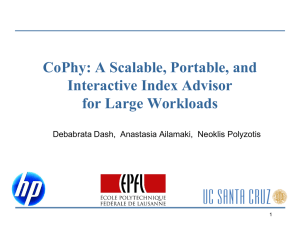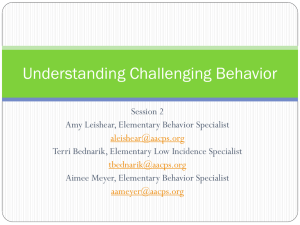IL Department of Healthcare & Family Services
advertisement
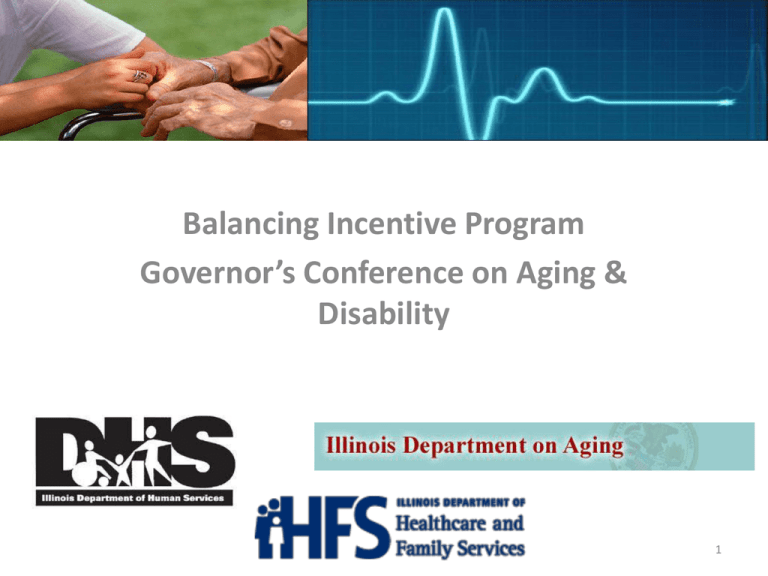
Balancing Incentive Program Governor’s Conference on Aging & Disability 1 What is the Balancing Incentive Program? The BIP was authorized under the Affordable Care Act (Section 10202) to assist states with improving access to Medicaid-funded home and community-based long-term services and supports (LTSS), and streamline program eligibility and service delivery to consumers between state agency programs. Participating states receive enhanced federal match through September 2015 to further rebalance long-term care delivery towards home- and community-based services. 2 Why BIP? Illinois’ Vision The BIP structural requirements support Illinois’ ongoing efforts to break down existing bureaucratic silos to better address individuals who have complex needs 3 Why BIP? Illinois’ Vision Illinois is embracing a number of federal opportunities to improve the coordination and integration of LTSS BIP is one opportunity under the Affordable Care Act (ACA) that promotes enhanced coordination. Illinois is participating in the Medicare/Medicaid Alignment Initiative. Illinois is a recipient of federal funding under the CMMI Model Design Grant – State Healthcare Innovation 4 Why BIP? Illinois’ Vision Illinois was already considering the adoption of a Uniform Assessment Process as a result of Legislative and Administrative Initiative The SMART act (PA 097-0689 and SB 2840) Illinois currently uses several assessment tools, depending on the consumer’s presenting issue. Existing tools do not capture all of the dataset domains required under the BIP. Illinois, like many states, is moving towards breaking down the silos and assessing consumers in a holistic manner. 5 Why BIP? Illinois’ Vision BIP – Benefits at the Ground Level Access to services will be streamlined and more efficient through the creation of numerous access points – web portal; 1-800 line; and physical agency access. Consumers will only have to tell “their story” one time – data will be shared across agencies to reduce duplication of effort and ensure that providers have necessary information to support consumers. Holistic approach to assessment process will enhance the linkage of consumers to services and supports and result in better health outcomes. 6 Key Elements of the BIP Required Structural Changes 1. 2. 3. No Wrong Door Conflict-Free Case Management Core Standardized Assessment (aka Uniform Assessment Tool) Additional Work Plan Requirements Information Technology coordination Data & Reporting Service data Quality measures Outcomes data Funding plan for structural changes Stakeholder Engagement Sustainability plan for the use of funds 7 Required BIP Structural Changes No Wrong Door / Coordinated Entry Process Develop a statewide system to enable consumers to access LTSS through a coordinated network or portal that will reduce existing fragmentation and duplication, improve coordination, and: Provide a streamlined/standardized intake process into the state ‘system’ Provide application assistance Provide referrals for services and supports available in the community Enable functional eligibility assessments Numerous Streamlined Entry Points: New LTSS website New 1-800 number Existing network of community-based agency offices 8 Conflict-Free Case Management Federal definition of “conflict-free” Separation of case management from direct service provision Separation of program eligibility determination from direct services provision Case managers cannot establish funding levels for the beneficiary Case managers cannot be related to the beneficiary or their caregivers Where conflict risk exists, states must establish firewalls and appropriate safeguards that assure consumer choice and protect consumer rights. Analysis of our current systems reveal that only some of our LTSS systems are compliant with CFCM. 9 Conflict-Free Case Management Conflict-Free Case Management Additional Design Elements Grievances, complaints, appeals, and the resulting decisions are adequately tracked and monitored. State agencies retain functional LTSS program eligibility determination and service provision business practices to ensure that consumer choice and control are not compromised. Consumer experiences are tracked and documented with measures that capture the quality of care coordination and case management services. 10 Uniform Assessment Process Uniform Assessment Tool (UAT) The UAT will, in a uniform and automated manner across the state: Assess functional eligibility for LTSS applicants Identify support needs Inform service planning Meet the Core Standardized Assessment BIP requirement 11 Uniform Assessment Process Uniform Assessment Process BIP requires assessment of consumers across a number of domains. Activities of daily living Instrumental activities of daily living Medical conditions Cognitive functioning Behavioral concerns BIP supports a holistic approach to the assessment process and service planning. The Determination of Needs (DON) tool focused on ADLs and IADLs with limited focus on behavioral health and other clinical domains. We will now see an improved assessment process that views consumers holistically which will lead to the development of comprehensive service plan. 12 Additional BIP Requirements Information Technology Coordination States must make an effort to coordinate their NWD system with other health IT initiatives. The IT System will be interoperable and will allow sharing of data across agencies to better support consumers. The Illinois Framework Project is committed to assisting the BIP team with planning the necessary IT improvements given the alignment of the mission of the Illinois Framework Project and the goals of the Balancing Incentive Program. 13 BIP Funding Sustainability Funding Plan Illinois is projected to receive approximately $90 million in enhanced FMAP under BIP. The $90 million is a calculated percentage of community LTSS expenditures. States must use the BIP funds in a manner that can be sustained after the program ends September 30, 2015 States should identify funding sources that will allow them to build and maintain the required structural changes 14 Funding Dos and Don’ts BIP funding is restricted to specific uses: Allowable Uses of BIP Funds Threshold tests for IL BIP spending: Does the activity increase offerings of or access to non-institutional LTSS? Does it contribute directly to increasing access to and utilization of LTSS in home and community settings? Does it provide a community alternative to immediate institutional placement? Does it expand community capacity that lengthens community tenure? Does the activity expand/enhance offerings/access that benefit Medicaid recipients? Is the activity something that Medicaid funds can typically be spent on (i.e. not prohibited use of Medicaid funding)? Prohibited Uses of BIP Funds Under federal law, BIP funds may not be used: X To match any other Federal funds. X To provide services, equipment, or supports that are the legal responsibility of another party under Federal or State law. X To supplant existing Federal, State, local, or private funding of infrastructure services. Sustainability: All activities must have a sustainable source of funds after BIP ends, unless they are onetime, non-recurring expenses. 15 Illinois’ BIP Timeline March 29, 2013: IL submitted BIP application June 12, 2013: IL received CMS approval to participate October 18, 2013: Initial work plan due to CMS October 2013-September 2015: Implement required structural changes September 30, 2015: BIP funding ends 16 IL BIP Contact Information Questions? Lora McCurdy BIP Project Director Illinois Department of Healthcare & Family Services Phone: 217-557-0997 Email: HFS.BIP@Illinois.gov http://mfp.illinois.gov/bip.html 17
